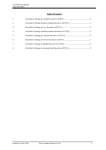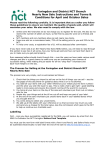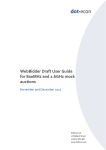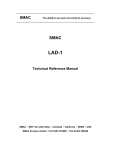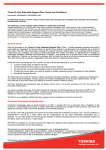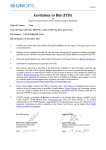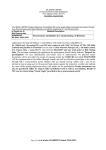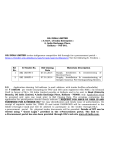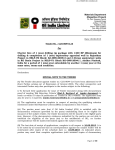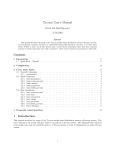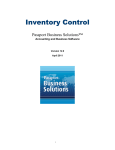Download DBA Bidder Seminar 01052012 v2-3x
Transcript
800MHz auction format and software 1st May 2012 1 Auction format 2 Combinatorial Clock Auction Format Principal Stage – determines the generic lots assigned to each bidder Primary rounds – clock auction format • Succession of rounds where auctioneer announces prices and bidders specify their demand (subject to activity rules); • If there is excess demand, further rounds may be run, with prices of lot categories in excess demand increasing • Primary rounds will end when there is no excess demand in any lot category Supplementary round – sealed bid round • Bidders may submit multiple mutually exclusive supplementary bids; • Bid amounts are subject to constraints that depend on bids submitted during the primary rounds Assignment Stage – determines specific frequencies to be assigned to each winner (required if more than one winner of B lots 3 only) Eligibility Each lot in the auction is assigned a number of eligibility points Exemption Eligibility is spectrum package specific: Spectrum Eligibility Points (SEP): 1 SEP per 2x5MHz; and Exemption Eligibility Points (EEP): 1 EEP per exemption in a coverage area EEP_A2B EEP_4B EEP_AB EEP_3B EEP_A EEP_2B EEP_B 3 1 3 3 1 3 3 All qualified bidders will start the auction with identical initial eligibility – EEP as in the table above and 4 SEP reflecting the spectrum cap of 2x20MHz 4 Activity rules Bidding in the primary rounds is subject to an eligibility-based activity rule: Bidders start the auction with a given level of eligibility In each primary round, bidders may only bid for combinations of lots adding to a total eligibility that does not exceed their eligibility In each primary round after the first round, the bidder eligibility will be adjusted to reflect their bid in the previous round • For spectrum eligibility, the eligibility is set to the total eligibility of spectrum lots bid for in the previous round • There are separate categories for exemption lots, and the adjustments depend on the spectrum lots bid for in the previous round Each time a bidder loses eligibility during the primary rounds, this will set some constraints on the supplementary bid amounts that the bidder may submit, to reflect the price differences prevailing in the round where the bidder made such choices – we call these the relative caps on supplementary bids A bidder’s choice of final primary round package will also set some constraints on the supplementary bid amounts that the bidder may submit 5 Relative caps on supplementary bids The bid amount for the package a bidder bids for in the final primary round is uncapped (except if the bidder has bid for a package containing no lots) Supplementary bids for any other package is subjected to a relative cap, determined by the bidder’s choice in the last round where the bidder would have been able to bid for that package, calculated using a revealed preference approach, as follows: Suppose the bidder was last able to bid for package X in round n, and bid for package Y instead. Let (X-Y)·pn be the price difference between X and Y in round n (when the bidder made the choice to bid for Y instead of X) Let B(Y) be the highest bid that the bidder submits for package Y (either during the primary rounds or in the supplementary bids round) The bid amount that the bidder may specify for package X will then be constrained to its highest bid for package Y (which the bidder preferred at the prices prevailing in round n when the bidder made its choice of Y over X) plus the price difference at the time of making that choice – therefore the relative cap on X is: B(Y)+(X-Y)·pn Note that: Where the bidder had sufficient eligibility to bid for X in the final primary round, then round n is the final primary round If package Y is the zero package, then the cap on the bid amount for X is the price of X in round n 6 Relative caps example A Round 1 Round price (DKK) Bid Round 2 Round price (DKK) Bid Round 3 Round price (DKK) Bid Round 4 Round price (DKK) Bid Round 5 Round price (DKK) Bid Round 6 Round price (DKK) Bid B E1 E2 E3 50m 50m 10m 10m 10m 0 4 1 0 0 60m 60m 20m 20m 20m 0 4 0 0 0 60m 70m 20m 20m 20m 0 3 1 1 0 70m 80m 30m 30m 30m 1 1 1 1 1 80m 90m 35m 35m 30m 0 2 0 0 0 80m 120m 35m 35m 30m 0 0 0 0 0 SEP EEP_ 4B EEP_ A2B EEP_ 3B EEP_ AB EEP_ 2B EEP_ A BBP _B 4 1 3 3 3 3 1 3 4 1 3 3 3 3 1 3 4 0 3 3 3 3 1 3 3 0 3 2 3 3 1 3 3 0 3 2 3 3 1 3 2 0 3 2 3 0 1 3 7 Relative caps Constrained Constraining Constraining Highest Price Cap (DKK) Package X Package Y Round n bid for Y difference (DKK) between X and Y in round n (DKK) A2B 3BE1E2 3 250m -50m 200m 4BE1 4B 2 240m 20m 260m 3BE1E2E3 3BE1E2 3 250m 20m 270m 3BE2E3 2B 5 180m 155m 335m 3BE1E2 2B 5 180m 160m 340m 2BE1 2B 5 180m 35m 215m 2B Zero package 6 0 240m 240m BE1E2E3 Zero package 6 0 220m 220m 8 Coverage obligation Required non-exempt bids: In order to be allowed to bid for a package that includes any exemptions from the coverage obligation, the bidder has to bid at least reserve prices for the corresponding spectrum package without any exemptions The auction outcome is restricted to those where the coverage obligation in a coverage area is assigned if suitable spectrum for meeting the obligation is assigned The determination of excess demand, winners and prices paid has to reflect this constraint 9 Winner determination The winner determination process selects a combination of bids that maximises total bid value subject to: Accepting at most one bid from each bidder Allocating no more lots than are available (including exemptions lots whose supply is endogenously determined by the number of winners of A and B lots) If there are multiple combination of bids that maximises total bid value, a tie break rule is applied in the following order: 1. 2. 3. 4. 5. 6. Combination with most winners Combination with most exemption lots awarded Combination with minimum unsold spectrum lots Combination with most winners subjected to a coverage obligation Combination with most clock-compatible bids when assessed against the primary bids submitted in the last primary round Random 10 Winner determination Bid ID Bidder A B E1 E2 E3 Bid Amount 1 2 Bidder1 0 2 0 0 1 DKK250m Bidder1 0 2 0 0 0 DKK150m 3 Bidder2 0 3 0 1 0 DKK300m 4 Bidder2 0 3 0 0 0 DKK150m 5 Bidder3 1 0 1 0 0 DKK60m 6 Bidder3 1 0 0 0 0 DKK50m Tied outcomes (DKK210m) Tie 1: 2&5 Tie 2: 4&5 Both outcomes share the same total bid value, therefore winning outcome will be determined in accordance to the tie-break rules: 1.Combination with most winners – identical in both ties, 2 winners each 2.Combination with most exemptions awarded – identical in both ties, 1 exemption awarded each 3.Combination with fewer unsold spectrum lots – Tie 1 has 2 unsold B lots while Tie 2 only has 1 unsold B lot. Therefore, our winning combination of bids is Tie 2, bid 4 and bid 5 are winning bids. 11 Determination of excess demand at the end of a primary round At the end of each primary round, a provisional winner determination is run on all bids received in the auction up to that point (there may be multiple solutions) If it is possible to select an optimal set of bids in which all bidders receive at least as many lots as they demanded at prevailing round prices, then there is no excess demand However, if in any provisional winning outcome, a bidder does not receive as many lots in a lot category as it demanded in the prevailing primary round, then there is excess demand in that lot category If there is excess demand, a further round may be run, with higher prices for lot categories in excess demand 12 Determination of excess demand Bid ID Price 1 Bidder1’s Primary Bid 2 Bidder1’s RNEB 3 Bidder2’s Primary Bid 4 Bidder2’s RNEB 5 Bidder3’s Primary Bid 6 Bidder3’s RNEB A (DKK50m) B (DKK50m) E1 (DKK10m) E2 (DKK10m) E3 (DKK10m) Bid Amount 0 2 0 0 1 DKK110m 0 2 0 0 0 DKK100m 0 2 0 1 0 DKK110m 0 2 0 0 0 DKK100m 1 1 1 0 0 DKK110m 1 1 0 0 0 DKK100m Provisional winning outcomes Bidder3 does not win any lots in this provisional winning outcome, so its demand for lot categories A, B and E1 cannot be met Tie 1: Bid 1&3 Bidder2 does not win any lots in this provisional winning outcome, so its demand for lot categories B and E2 Tie 2: Bid 1&5 Tie 3: Bid 3&5 Bidder1 does not win any lots in this outcome, so its demand for lot categories B and E3 cannot be met There is excess demand in all lot categories 13 Base prices Each winner has to pay a base price for its winning bid Base prices are required to satisfy the following properties: The base price will be at least the package reserve price and no higher than the winner’s winning bid The sum of base prices that apply to any subset of winners needs to be at least the opportunity cost of assigning those winners the lots included in their winning bids (i.e. no other combination of bidders has offered to pay more for these lots) Subject to the restrictions above, the total sum of base prices is minimised, in order to reduce incentives for bidders to shade their bids We calculate the opportunity cost of a subset of winners as the difference between: The value of bids that would be selected as winning bids if any bids from winners in the subset are excluded except their non-exempt bids, which are included at reserve prices; and The value of winning bids in the original auction outcome from winners not included in the subset 14 Calculating base price in our previous example Bid ID Bidder A B E1 E2 E3 Bid Amount 1 2 Bidder1 0 2 0 0 1 DKK250m Bidder1 0 2 0 0 0 DKK150m 3 Bidder2 0 3 0 1 0 DKK300m 4 Bidder2 0 3 0 0 0 DKK150m 5 Bidder3 1 0 1 0 0 DKK60m 6 Bidder3 1 0 0 0 0 DKK50m Bidder 2 won 3B lots with its bid of DKK150m while Bidder 3 won the A lot and E1 with its bid of DKK60m. The total value of winning bids is DKK210m. Considering only non-exempt bids from Bidder 2, the optimal combination of bids that yield the highest total bid value of DKK210m is the set of bid4 and bid5 or the set of bid2 and bid5. Considering only non-exempt bids from Bidder 3, the optimal combination of bids that yield the highest total bid value of DKK200m is the set of bid4 and bid6 or the set of bid2 and bid6. Considering only non-exempt bids from Bidder 2 and Bidder 3, the optimal combination of bids that yield the highest total bid value of DKK200m is the set of bid2 and bid6 or the set of bid4 and bid6. 15 Calculating base prices Individual opportunity cost: Bidder2 = 210 – (210-150) = 150 Bidder3 = 200 – (210-60)= 50 Joint opportunity cost of Bidder2 and Bidder3: 200 – (210-210)= 200 This is equal to the aggregate sum of Bidder2 and Bidder3’s individual opportunity cost (150+50=200) Therefore, setting base prices for Bidder2 and Bidder3 that are equal to their individual opportunity cost would be sufficient to meet the requirement that they jointly pay no less than their joint opportunity cost Bidder2’s individual opportunity cost is equal to the reserve price for the package it wins, so we can set its base price to DKK150m Bidder3’s individual opportunity cost is below the reserve price for the package it wins, therefore the base price for Bidder3 needs to be set to the reserve for its package (DKK60m) 16 Auction software 17 Electronic Auction System (EAS) Bidding through EAS over the public internet using a web browser (Internet Explorer, Firefox or Chrome): Bid submission process requires two steps: EAS provides bid forms and information about prices set by the auctioneer and round results Provided that they user remains connected to the EAS, the interfaces will automatically update as the auction progresses – providing relevant page (e.g. bid form during a round) EAS also provides auction history of rounds already completed and approved by the auctioneer, which may also be downloaded Submission of supplementary bids may be done on the interface, and an upload facility for submission of bids from tab delimited text files is also available Submission of a decision, which is then checked for validity at the server end; If the decision checked is valid, the bidder may then formally submit that decision (or revert to the bid form if it wishes to amend its decision) Failure to submit a bid within the specified round time window may trigger an a round extension (if the bidder has extensions available – each bidder will start the auction with two extension rights for the primary rounds, and one for each the supplementary and the assignment round) Hands on trial of the EAS during mock auction, a user manual will also be provided to qualified bidders 18 Electronic Auction System (EAS) An up-to-date version of Java must be installed on the terminal used to access the EAS Authentication: Access is controlled by purpose-built user-specific digital certificates distributed by the auctioneer to bidders, which will need to be installed on the terminal used to access the EAS A login password is also required to access the EAS, which will be provided by the auctioneer Different terminals may be used by each user to access the EAS, but only one session at a time is allowed (no parallel logins) Sessions automatically terminated if user loses connection, so that the user may be able to connect from a different terminal All requests submitted by users are logged 19















